
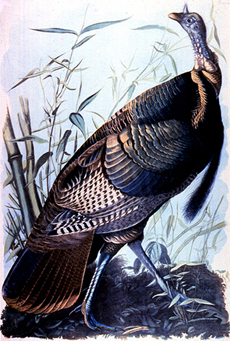 Turkey Cock Turkey Cock, chromo lithography by John James Audubon, 1858. Courtesy Wake Forest University.
November 2005
|
 |
The History of the Turkey
A Great Native American
Our interest in turkey has been increasingly steadily, reports the National Turkey Federation. Perhaps because it’s a healthy, low-caloric, low-cost meat that most people enjoy; perhaps because the introduction of the turkey breast made it easier for home cooks to roast a bird (and an all-white-meat bird, at that). For these and other reasons, over the past thirty years, we’ve doubled our annual consumption of turkey, from 8.7 pounds of turkey per capita in 1974, to 17.1 pounds per person last year. That’s something to gobble about!
Of course, 99 percent of those turkeys are likely Broad Breasted Whites, the commercial supermarket turkeys bred over the last fifty years to satisfy Americans’ taste for white meat. The common ancestor for the Broad Breasted White as well as the heritage turkey breeds that are making a comeback is the wild turkey that is native to the forests of the Americas. The Conquistadors encountering the Aztec empire found domesticated turkeys, and brought them back to Spain along with other New World foods.
According to William Rubel, an expert in traditional American foods, the first birds arrived in Spain in 1498, where they were embraced—turkey was the New World food most easily adopted by Europeans. Mutations occurred, and different breeds of turkeys developed, including the Black and the White Holland.
Turkey was established in England by the 1540’s. By the 1570’s they were raised throughout the country, and were already part of the Christmas feast. Rubel quotes a writer praising the joys of a “well drest turkey” for Christmas dinner, almost 50 years before the Pilgrims set sail:
Good bread and good drink, a good fire in the hall;
Braun, pudding and sauce, and good mustard withal;
Beef, mutton and pork, shred pies of the best;
Pig, veal, goose and capon, and turkey well drest;
Cheese, apples and nuts; jolly carols to hear;
All these in the country are counted good cheer.
—Thomas Tusser, 1573
Turkey was thus not new to the Pilgrims: by the time the colonists came to establish the Plymouth Colony in the early seventeenth century, they were well acquainted with the birds. In fact, the early English settlers to the Plymouth Bay Colony brought Black turkeys with them. Although there were wild turkeys in the forests, they wanted domesticated turkeys for their barnyards: domesticated turkeys provide a reliable source of meat throughout the year. “Tame turkeys” were on the list of expedition supplies requested by the Massachusetts governor in 1628.
|
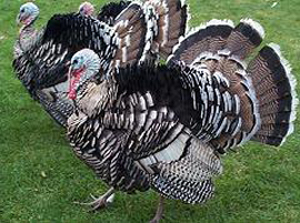 |
| Othala Acres breeds Narragansetts, the “original” American
domesticated breed, in Troy, New Hampshire. They are in
the process of becoming a rare breeds preservation farm,
raising and offering endangered heritage varieties of poultry, waterfowl and livestock. |
The Black was bred with its ancestor, the wild North American turkey. The Narragansett was the result and the other breeds followed: the Standard Bronze was bred from Narragansett and Eastern wild turkeys; the Bourbon Red was developed from the Jersey Buff.
By reading English cookbooks published in the seventeenth through nineteenth centuries, one can see that turkeys were eaten for much of the year. In the early summer the birds were small. In the fall and early winter the birds were large. Those generations were more attuned to the culinary versatility of turkeys: a young bird with “soft beak and toes” yields tender, mild breast meat; an older bird yields a more flavorful roast. Cookbooks often specified small turkeys—even as small as six pounds. Birds were available of a size suitable for everyday dinner.
For more information on the history of turkeys in America, click here to see William Rubel’s full article.
For more information on a number of classic American foods, visit William Rubel’s website, WilliamRubel.com.
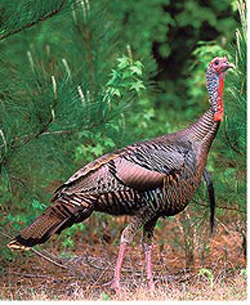
|
By the way, for those wondering what happened to those original wild turkeys: if you live in the country, or what was formerly country and is now creeping suburbia, we don’t have to tell you—you probably see plenty of them. The National Wild Turkey Federation reports an population explosion to nearly seven million birds—a hearty percentage of the roughly 46 million domesticated birds that will be eaten this Thanksgiving.
Unlike their caged cousins, wild turkeys fly. They roost high in trees and on rooftops to avoid predators. Aggressive toms will attack humans with the spurs on their heels; and will peck at and scratch cars, believing their reflections to be enemy birds.
|
| The Eastern Wild Turkey. Photograph by Larry
Price, courtesy of the National Wild Turkey Federation. |
To learn more about the history of food:
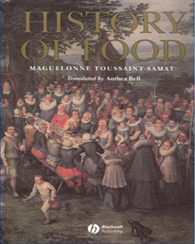 |
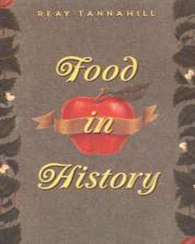 |
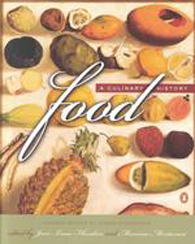 |
History of Food, by Maguelonne Toussaint-Samat. The story of cuisine and the social history of. Lean how man transitioned from a vegetarian to an increasingly meat-based diet, as well as between particular foods and social behavior. Click here for more information or to purchase. |
Food in History, by Reay Tannahill. A world history of food from prehistoric times to the present, packed with intriguing information, lore, and startling insights—like what cinnamon had to do with the discovery of America, and how food has influenced population growth and urban expansion. Click here for more information or to purchase. |
Food: A Culinary History from Antiquity to the Present, edited by J. Flandrin et al. The evolution of food, meals, and eating customs from the first prehistoric hunters to the fast-food chains of today, and how they all have had an impact on culture. For example, the Black Plague is credited for the use of individual portions rather than a community plate. Click here for more information or to purchase.
|

|




 Turkey Cock, chromo lithography by John James Audubon, 1858. Courtesy Wake Forest University.
Turkey Cock, chromo lithography by John James Audubon, 1858. Courtesy Wake Forest University. 

